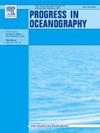Spatiotemporal changes in the community and demography of mesozooplankton in the eastern Indian sector of the Southern Ocean during austral summer 2018/2019
IF 3.8
3区 地球科学
Q1 OCEANOGRAPHY
引用次数: 0
Abstract
The Southern Ocean is facing rapid environmental changes. However, few studies have been conducted on the spatiotemporal variability of mesozooplankton communities under recent climatic conditions, particularly in the eastern Indian sector. This study describes the spatiotemporal variability of the mesozooplankton community and the demographics of large copepods and krill in this sector, sampled through a Rectangular Mid-Water Trawl with 1 m2 mouth area (RMT1) during the austral summer of 2018/2019 as part of the KY1804 survey. Cluster analysis indicated that the mesozooplankton community was divided into five groups that showed only small longitudinal differences, as they were affected by oceanic fronts. Part of the variability was explained by physical (local upwelling) and biological features (e.g., the occurrence of species showing a specific spatial distribution, such as Euphausia crystallorophias). Horizontal changes in the zooplankton community structure were not attributed to temporal changes during the 2-month sampling period. The demographics of the dominant species, Calanoides acutus, Calanus propinquus, Metridia gerlacheri, and Thysanoessa macrura, exhibited significant temporal differences in abundance or mean stage index (MSI) between the early and late seasons. These differences matched the growth rates estimated in previous studies, suggesting that their growth during the study period was constant without regional differences. There were no evident changes in the abundance or demographics of Rhinalanus gigas, suggesting that they were in their reproductive season. These species-specific demographics could be explained by the species life cycles: growth in C. acutus and C. propinquus and reproduction in R. gigas during the austral summer. Abundances and MSIs confirmed the growth of dominant copepods and krill during the sampling period; however, no evident seasonal changes were observed in the zooplankton community structure. The findings of this study contribute to the understanding of lower trophic levels in marine ecosystems and the present carbon cycle in the eastern Indian sector of the Southern Ocean.
2018/2019年澳大利亚夏季南大洋东印度洋段中生浮游生物群落和种群的时空变化
南大洋正面临着快速的环境变化。然而,有关近期气候条件下中浮游生物群落时空变化的研究很少,尤其是在东印度洋海区。作为 KY1804 调查的一部分,本研究描述了 2018/2019 年澳大利亚夏季通过口部面积为 1 平方米的矩形中层水拖网(RMT1)对该水域中层浮游生物群落的时空变异性以及大型桡足类和磷虾的人口统计学特征。聚类分析表明,中生浮游生物群落分为五个组,由于受到海洋锋面的影响,这些组只显示出很小的纵向差异。物理(局部上升流)和生物特征(如出现特定空间分布的物种,如结晶大孔 Euphausia)解释了部分变异性。浮游动物群落结构的水平变化与两个月采样期间的时间变化无关。优势种(Calanoides acutus、Calanus propinquus、Metridia gerlacheri 和 Thysanoessa macrura)在丰度或平均阶段指数(MSI)方面在早季和晚季之间表现出显著的时间差异。这些差异与以往研究中估计的生长率相吻合,表明它们在研究期间的生长是恒定的,没有区域差异。千层塔鱼的数量或人口统计学特征没有明显变化,这表明它们正处于繁殖季节。这些物种特有的人口统计学特征可以用物种的生命周期来解释:尖吻鳕和丙鳞鳕在生长期,而千头鳕在夏季繁殖期。丰度和 MSIs 证实了取样期间优势桡足类和磷虾的增长;然而,浮游动物群落结构未观察到明显的季节性变化。这项研究的结果有助于了解海洋生态系统中的低营养级以及南大洋东印度洋区目前的碳循环情况。
本文章由计算机程序翻译,如有差异,请以英文原文为准。
求助全文
约1分钟内获得全文
求助全文
来源期刊

Progress in Oceanography
地学-海洋学
CiteScore
7.20
自引率
4.90%
发文量
138
审稿时长
3 months
期刊介绍:
Progress in Oceanography publishes the longer, more comprehensive papers that most oceanographers feel are necessary, on occasion, to do justice to their work. Contributions are generally either a review of an aspect of oceanography or a treatise on an expanding oceanographic subject. The articles cover the entire spectrum of disciplines within the science of oceanography. Occasionally volumes are devoted to collections of papers and conference proceedings of exceptional interest. Essential reading for all oceanographers.
 求助内容:
求助内容: 应助结果提醒方式:
应助结果提醒方式:


